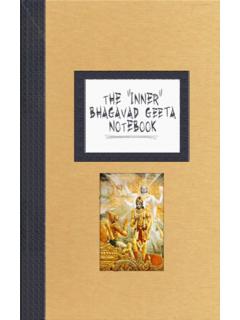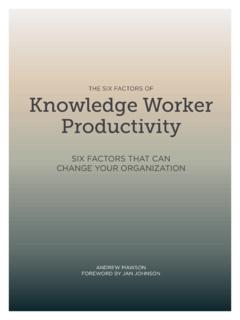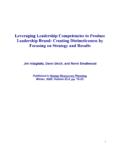Transcription of The Zen Koan Notebooks - Stephen H. Wolinsky …
1 The Zen Koan NotebooksCourse ICracking the Code of the Zen KoanThe Zen of Advaita-VedantaThe TeAC hIN g MAsTery of srI N IsArgAdATTA MAhArAjCopyright 2010 Stephen H. Wolinsky , PhD An imprint of Quantum Press, under the auspices of Quantum Institute H. Wolinsky , PhD Library ISBN 0-9749954-3-6website : Bramble Books cover design byMike bySimon is no oneThere is nothing and no one to get No one to receive a teachingNo one to give a teachingThat being saidWho hears?Who reads?Let s beginNisargadatta Maharaj: There is no such thing as enlightenment,the realization of that fact is itself enlightenment. 4forwArdAll spiritual paths are pointers at best and become religious dogma at worst. Zen, although a clean form of Buddhism with its magnificent Koans which both lure and attract the deconstruction or de-conditioning of the mind, nevertheless carries with it (if these Koans are taken as a real thing, a real roadmap a real path, that will do the job) the same traps as any other Saying: If you fall in love with the road, you will forget the Maharaj: I do not believe in spiritual paths lead to unreality.
2 I was drawn to Zen in the early 1970 s with one of their most famous Koans, What is the sound of one hand clapping? Although hypnotized by the puzzle, I did not realize and experience one of its meanings 5until 1975, (that there is no such thing as choice, and that there was no purpose). In 1979 I spoke to Nisargadatta Maharaj about this, (that there is no such thing as choice, and that there was no purpose, and everything just happens as it happens) wanting to test my understanding . He replied, Obviously. The structure of the Koan however was not revealed in its entirety for almost 20 book represents several things:A cracking of the code of the 1. Zen Koan and appreciating the Koan, its purpose , how it works , and where it leads.
3 A completion of the queue 2. of the mind, with its extraordinary capacity to deconstruct, without any regard from a me . In other words it just realization of my beloved 3. Sri Nisargadatta Maharaj as the 6ultimate Zen Teaching Master, who used Enquiry like a the reader and myself 4. the danger of realizing that even the magnificent Koan is still a thorn to remove a thorn. Better said, the Koan deconstructs and points, but one cannot nest in the beyond or any experience that arises , even satori. In short, the Zen Koan too, like the enquiry process, must , this represents 5. yet another tribute to Sri Nisargadatta Maharaj, who was able to pinpoint where the imaginary I imagined it was, and set it free from its illusionary existence.
4 This book is offered to Maharaj, whose Teaching Mastery leaves me in awe and reverence, even twenty-nine years after his GurudevNisargadatta Maharaj Ki Jaya!7seCTIoN oNewATCh your sTeP! A word of CAuTIoNNisargadatta Maharaj: Question everything, don t believe anything. As you are about to go through this book, please note that nothing you are about to read is true. It is merely words which represent things which do not do not fall into the trap of two Archetypes, (current patterns in the ocean that form waves, then bubbles, the I , as droplets).The First Archetype is of the Genie in the Lamp . In this current the right words (magic words) must be said (chanted) for the genie to appear and grant your wishes (kind of like mantras).
5 The second Archetypical current is Using a Treasure Map to Search for the 8 Buried Treasure . Like spiritual paths searching for enlightenment (the Holy Grail of the spiritual quest).Why is this important to remember as we tread through this series of books? Because all pointers and metaphors are using words which represent and describe things which do not exist. In short, Don t fall into words and language games .Finally, be aware of precognitive traps that offer pleasure and rewards for understanding and learning the words and their meanings. This deeply embedded current only assures more craving and a fixation on learning more and more words to have more and more experiences with the belief that both experiences words and understanding will lead to the ultimate experience, termed some form of bliss for all eternity called Enlightenment.
6 Nisargadatta Maharaj: ..all experiences will lead you to is more nothing from 9As we will see Koans, like Enquiry Questions, are designed to break language patterns. BUT, throw the thorn away, (step away from word-meanings and understanding) otherwise you will fall into the trap of words and the joy of learning and experiencing their LoveYour Mirage BrotherStephen 10 INTroduCTIoNwhat is the history of Zen?Zen comes from the word ch an in Chinese which comes from the word dhyana in Sanskrit. Dhyana is part of the eight limbs of yoga (the 7th limb) and means meditation. Zen therefore has its roots in India as early as 5300 years ago, although it was not revealed in its present form until about 2500 years ago upon the appearance of Sakyamuni itself as its Chinese incarnation as Ch an did not appear until about 500 with the arrival of Bodhidharma in is Zen?
7 Enquiry Koan: Is there Zen prior to the word Zen?Often times Zen masters are asked, What is Zen? From that question many paradoxical answers are 11given. What becomes apparent is that any understanding in words or concepts yields more and more concepts which keep you from appreciating that whatever you think it is, it is Maharaj: Everything you understand, you understand through your concepts. The easy way to define Zen is meditation. Zen Buddhism dates back to India and the root of Zen is Hindu, which later was reformed as Buddhism some 500 years before the birth of was a Hindu. His realization led him to define what later became , who many consider the founder of modern day Zen, brought dhyana (meditation ) to China from India about 500 root of Zen meditation, like the root of meditation, in very general terms is neti neti, translated from the Sanskrit as not this not ZenOne of the biggest problems and one which still remains largely unseen, is when there is an attempt to transplant spirituality from one culture to another.
8 For example one might transplant Indian yoga to the West. However the psychology, the cultural metaphors, in short the way that the mind is organized, might be very different in the West from the East. Appreciating this, my teacher Nisargadatta Maharaj tried to teach the particular student according to how their mind was organized. To illustrate, he taught me using Western scientific metaphors, while many of his Indian disciples received traditional Indian cultural metaphors. This is critical to appreciating the problems of getting techniques or teachings that are transplanted from one culture to another, from one time period to another, not to mention from one person to Zen stories of teachers demonstrate these cultural metaphors that relate to earlier times in history and which do not hit the mark in the Post-Modern World.
9 Pain oftentimes follows for students when the culture and time are not appreciated and are superimposed like a template or a map or a belief system upon someone, or a group, that it is not appropriate : It is better to do your own path imperfectly, than another s perfectly. From a relative point of view, arguably much of the pain that is felt within spiritual communities is because there is a tendency by teachers to give spiritual practices as a one-size-fits-all. In other words, everyone automatically gets the same mantra, yantra, tantra, spiritual practice. This leads a student for whom the approach has been given inappropriately to feel there must be something wrong with me . 14 Instead it is essential to receive the right key to your door applied in the right moment in space-time to liberate the you you imagine yourself to be.
10 I know personally in my case my teacher Sri Nisargadatta Maharaj said to me one day quite unexpectedly, fluids come together and the I Am appears. At first glance, for another person who might be sitting next to me, (one of the other five or six people in the room), this might not have any meaning at , Maharaj s Enquiry Koan which he applied to me as he did, sent a piece of my consciousness into the world of neuroscience leaving me with basic experiential Yoga understandings that I was not I , that I and the sense of being a person separate from other persons occurred through fluids in the brain coming together, and that there was no cause or effect, doership or location. In short, as he said to me, It s all an illusion.




